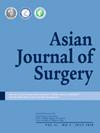内腔腹腔镜腹股沟疝修补术中浓缩聚四氟乙烯疝气网片与其他复合网片的比较研究。
IF 3.5
3区 医学
Q1 SURGERY
引用次数: 0
摘要
导言:腹腔镜腹股沟疝网片修补术(LVHR)越来越受欢迎,这可能是因为它能减少并发症、缩短住院时间、尽早恢复工作和改善外观。腹膜内镶嵌法(IPOM)采用双层复合网片,内脏表面有可吸收屏障,以减少肠粘连。聚丙烯(PP)、聚酯和膨体聚四氟乙烯(ePTFE)是三种最常用的人造网支架。新一代单层缩聚聚四氟乙烯(cPTFE)Omyra® 网片目前已投入使用,这种网片理论上能更好地与顶叶组织结合,可能会减少与内脏器官的粘连:我们的研究旨在评估 Omyra(cPTFE)网片与其他类型网片在 LVHR 中的安全性和有效性:我们回顾性地收集了 2011 年 1 月 1 日至 2020 年 12 月 31 日期间使用 cPTFE 和其他类型网片进行 LVHR 手术的 62 例患者的数据。我们记录并分析了患者的人口统计学特征、疝气特征、围手术期事件、术后结果和并发症:在研究的 62 名患者中,Omyra 组有 27 人(43.55%),其他合成网片组有 35 人(56.45%)。Omyra 组患者的平均年龄为 53.19 岁(31-85 岁),其他合成网片组患者的平均年龄为 55.03 岁(22-81 岁)。在患者人口统计学和主要合并症方面没有差异。就诊时,Omyra 组比其他合成网片组更常见的适应症是复发(p = 0.043),患者症状更重(p = 0.0034)。平均手术时间、术后恢复和并发症以及随访期间的早期(30 天)并发症均无差异:结论:在 LVHR 手术中,使用 cPTFE(Omyra™)网片与其他合成网片的手术效果相当。Omyra 和其他合成网片组的围手术期并发症和早期复发率相似。本文章由计算机程序翻译,如有差异,请以英文原文为准。
A comparative study between condensed polytetrafluoroethylene mesh versus other composite meshes in Endo-laparoscopic ventral herniorrhaphy
Introduction
Laparoscopic ventral hernia mesh repair (LVHR) is gaining popularity possibly due to reduced complications, reduced hospital stay, early return to work and better cosmesis. In intra-peritoneal onlay method (IPOM) a dual layer composite mesh with an absorbable barrier on the visceral surface is used for minimising bowel adhesions. Three most popular prosthetic mesh scaffolds are polypropylene (PP), polyester and expanded polytetrafluoroethylene (ePTFE). A new generation of monolayer condensed polytetrafluoroethylene (cPTFE) Omyra® mesh, which theoretically has better tissue integration with parietal tissue and possibly lesser adhesions with visceral organs is now available for use.
Objective
The aim of our study is to assess the safety and efficacy of Omyra (cPTFE) mesh versus other mesh types in LVHR.
Method
We retrospectively collected data from 62 patients who underwent LVHR using cPTFE, as well as other mesh types from January 1, 2011 to December 31, 2020. Patient demographics, Hernia Characteristics, perioperative events, postoperative results and complications were documented and analysed.
Results
Among the 62 patients studied, there were 27 (43.55 %) in the Omyra group and 35 (56.45 %) in the other synthetic meshes group. The mean age of the Omyra group was 53.19 (31–85) and 55.03 (22–81) for the other synthetic meshes group. There were no differences in terms of patient demographics and major comorbidities. At presentation, the indication was more commonly for recurrence (p = 0.043), and patients were more symptomatic (p = 0.0034) in the Omyra group than the other synthetic meshes group. There were no differences in mean operating time, post-operative recovery and complications, as well as early (<30 days) and late (>30 days) complications during follow up.
Conclusion
The use of cPTFE (Omyra™) mesh yielded comparable operative characteristic compared to other synthetic meshes for LVHR. The rate of perioperative complications and early recurrence was similar between Omyra and other synthetic meshes group.
求助全文
通过发布文献求助,成功后即可免费获取论文全文。
去求助
来源期刊

Asian Journal of Surgery
医学-外科
CiteScore
3.60
自引率
31.40%
发文量
1589
审稿时长
33 days
期刊介绍:
Asian Journal of Surgery, launched in 1978, is the official peer-reviewed open access journal of the Asian Surgical Association, the Taiwan Robotic Surgery Association, and the Taiwan Society of Coloproctology. The Journal is published monthly by Elsevier and is indexed in SCIE, Medline, ScienceDirect, Scopus, Embase, Current Contents, PubMed, Current Abstracts, BioEngineering Abstracts, SIIC Data Bases, CAB Abstracts, and CAB Health.
ASJSUR has a growing reputation as an important medium for the dissemination of cutting-edge developments in surgery and its related disciplines in the Asia-Pacific region and beyond. Studies on state-of-the-art surgical innovations across the entire spectrum of clinical and experimental surgery are particularly welcome.
The journal publishes original articles, review articles, and case reports that are of exceptional and unique importance. The journal publishes original articles, review articles, and case reports that are of exceptional and unique importance.
 求助内容:
求助内容: 应助结果提醒方式:
应助结果提醒方式:


